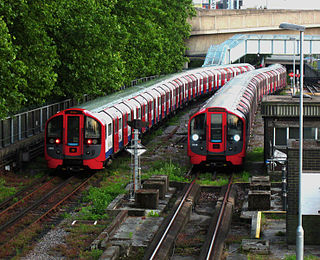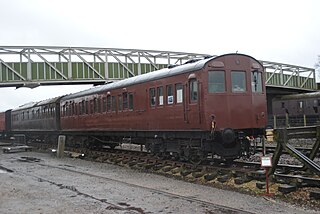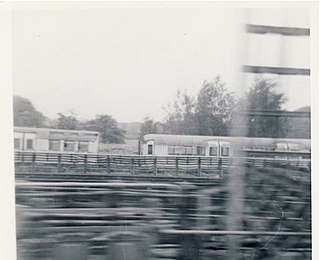
London Underground rolling stock includes the electric multiple-unit trains used on the London Underground. These come in two sizes, smaller deep-level tube trains and larger sub-surface trains of a similar size to those on British main lines, both running on standard gauge tracks. New trains are designed for the maximum number of standing passengers and for speed of access to the cars.

The London Underground 1938 Stock was a London Underground tube stock design. A total of 1,121 cars were built by Metro-Cammell and Birmingham RC&W. An additional 173 cars were added to the fleet by the end of 1953, comprising 91 new builds, 76 conversions from Pre-1938 Tube Stock or 1935 Tube Stock, and six unconverted cars of 1935 Tube Stock, and the stock was used on the London Underground until 1988. During their long lives they worked on the Bakerloo, Northern, Piccadilly, East London, Central, and Northern City lines. Ten sets were refurbished and ran on the Isle of Wight as Class 483, making them the oldest passenger rolling stock operating timetabled services on the National Rail network at the time of their withdrawal in January 2021. The trains represented a major technical advance, as all the electrical equipment was located under the floor for the first time. All previous tube stock had large equipment compartments behind the driving cabs in motor cars, which reduced the space available for passengers by about a third.

The Standard Stock title was applied to a variety of Tube stock built between 1923 and 1934, all of which shared the same basic characteristics, but with some detailed differences. This design is sometimes referred to as 1923 Tube Stock, 1923 Stock, or Pre 1938 Stock. Most of the Standard Stock was built to replace the first generation of "Gate Stock" Tube trains or to provide additional trains for extensions built in the 1920s and early 1930s. Standard Stock cars consisted of motor cars, with a driver's cab, behind which was a "switch compartment" occupying approximately one-third of the length of the car, plus trailer cars and "control trailers", with a driving cab but no motor. All were equipped with air operated sliding doors. The guard's door on the earlier trains was a manually operated, inward-opening hinged door.

The T Stock was a series of electric trains originally built in various batches by Metropolitan-Vickers and the Birmingham Railway Carriage and Wagon Company for the Metropolitan Railway in 1927–31 for use on electric services from Baker Street and the City to Watford and Rickmansworth, though rarely some worked on the Uxbridge branch.

The London Underground R Stock electric multiple units were used on London Underground's District line from 1949 to 1983. Composed of new cars and converted Q38 Stock trailers, the cars were built and converted in three batches between 1949 and 1959. The cars were driving motors (DM) or non-driving motors (NDM), there being no unpowered trailers. The second batch, introduced in 1952, was constructed from aluminium, saving weight and one train was left unpainted as an experiment. Considered a success, trains were left unpainted or painted white or grey to match in 1963–68. Originally designed to operate in trains with six off-peak and eight cars during peak hours, the trains were reformed as fixed seven-car trains in 1971. R Stock trains were replaced by the D78 Stock and withdrawn between 1981 and 1983.

The G Stock were 50 electric multiple unit train carriages built for the District Railway in 1923 by Gloucester RC&W. They operated on the District line of the London Underground until 1971.

The London Underground O and P Stock electric multiple units were used on the London Underground from 1937 to 1981. O Stock trains were built for the Hammersmith & City line, using metadyne control equipment with regenerative braking, but the trains were made up entirely of motor cars and this caused technical problems with the traction supply so trailer cars were added. P Stock cars were built to run together with the O Stock cars now surplus on Metropolitan line Uxbridge services. The trains had air-operated sliding doors under control of the guard; the O Stock with controls in the cab whereas the P Stock controls in the trailing end of the motor cars. The P Stock was introduced with first class accommodation, but this was withdrawn in 1940.

The London Underground 1960 Stock was a class of electric multiple unit for the London Underground Central line. Twelve motor cars were supplied by Cravens, and pairs were made up to four cars by the addition of two converted standard stock trailers. A production run of 338 motor cars was shelved, due to the time needed to assess the new features and the cost of converting the trailer cars. Some of the pre-1938 trailers were later replaced by 1938 stock trailers.
The D Stock was built by Metropolitan Amalgamated Railway Carriage & Wagon in Saltley, England for the District Railway in 1912. A total of thirty cars were built, twenty-two were driving motor cars and eight were trailers. In 1928 the eight trailer cars were rebuilt into motor cars at Acton Works.
The C Stock was built for the District Railway in 1910. The additional rolling stock was required to increase the frequency of the service, plus the four-tracking of the section west of Hammersmith which allowed a greater frequency of trains to and from Richmond.

The London Underground B Stock was built in 1905 for the District Railway. 420 vehicles were built, formed into 60 seven-car units.

The London Underground 1967 Stock was a type of deep-level train that operated on the Victoria line of the London Underground from the line's opening on 1 September 1968 until 30 June 2011. It was also used on the Central line between Woodford and Hainault between 21 February 1968 and 1984, as the same automatic train operation (ATO) system was used on both lines.

The British Rail Class 501 electric multiple units were built in 1955/56 for use on the former LNWR/LMS suburban electric network of the London Midland Region. A total of 57 three-car units were built.
The London Underground F Stock was built in 1920 and 1921 for the District Railway by the Metropolitan Carriage, Wagon and Finance Company. They were partly funded by the government as part of an initiative to help British industry recover from World War I. One hundred steel-bodied cars were built: 40 driving motors, 12 control trailers and 48 trailers with the first train entering service on 23 December 1920. The cars were built with manually-operated sliding doors.

The London Underground 1935 Stock was an experimental train design by Metropolitan Cammell in London. Twelve two-car units, marshalled into four six-car trains, were built. They served as the prototypes for the later 1938 Stock.

The London Underground Q Stock were trains used on the District line of the London Underground. First introduced in 1938, these electric multiple units were formed from cars built between 1923 and 1935 and new purpose-built cars, and fitted with electro-pneumatic brakes and guard controlled air-operated doors. Trains were made up from cars of different ages with differing appearances, the older ones with clerestory roofs and the newer ones with flared sides. Some units were withdrawn in the early 1960s, although six- and eight-car trains remained on the District line with use gradually diminishing to peak hours only, and four car units worked the East London line until 1971.

Metropolitan Railway electric multiple units were used on London's Metropolitan Railway after the lines were electrified in the early 20th century.

District Railway electric multiple units were used on London's Metropolitan District Railway after the lines were electrified in the early 20th century.

The history of the District line started in 1864 when the Metropolitan District Railway was created to create an underground 'inner circle' connecting London's railway termini. The first part of the line opened using Metropolitan Railway gas-lit wooden carriages hauled by steam locomotives. The District introduced its own trains in 1871 and was soon extended westwards through Earl's Court to Fulham, Richmond, Ealing and Hounslow. After completing the 'inner circle' and reaching Whitechapel in 1884, it was extended to Upminster in East London in 1902. To finance electrification at the beginning of the 20th century, American financier Charles Yerkes took it over and made it part of his Underground Electric Railways Company of London (UERL) group. Electric propulsion was introduced in 1905, and by the end of the year electric multiple units operated all of the services.

Departmental locomotives on the London Underground consist of vehicles of a number of types which are used for engineering purposes. These include battery locomotives, diesel locomotives, electric locomotives, sleet locomotives, pilot motor cars and ballast motor cars. Details of the first four types are covered elsewhere. Pilot motor cars and ballast motor cars are generally vehicles which have been withdrawn from passenger service, but continue to be used by the engineering department. Pilot motor cars are used to move other vehicles around the system, while ballast motor cars are used to haul ballast trains and engineering trains.














